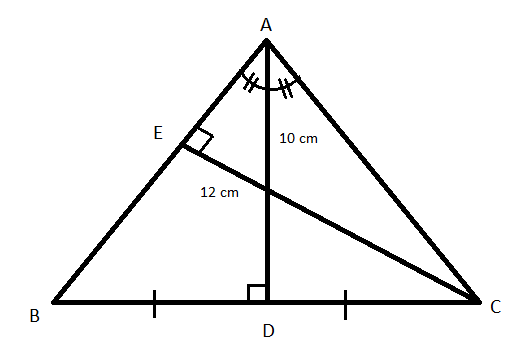Question
Question: In an isosceles triangle \[ABC\left( {AB = AC} \right)\], the altitude to the base and to the latera...
In an isosceles triangle ABC(AB=AC), the altitude to the base and to the lateral side are equal to 10 cm and 12 cm respectively. The length of the base is
A. 12.5
B. 15
C. 16
D. 18
Solution
In this question, we will be using the formula of half-angles in trigonometry and using the sides of the triangle we will obtain the unknown sides. Also, we will use the property of altitude to the base in case of isosceles triangle to get the required solution. So, use this concept to reach the solution of the given problem.
Complete step by step answer:
Given ΔABC is an isosceles triangle with AB=AC. Let AD be the altitude to the base and CE be the altitude to the lateral side whose length are equal to 10 cm and 12 cm respectively as shown in the below figure:

By applying sinB in ΔABD and ΔBCE, we get
We know that the altitude to the base divides the angle at where the two equal side lengths meet into two equal angles.
So, ∠BAC=21∠BAD=21∠DAC
We know that altitude to the base in an isosceles triangle divides the base in two equal parts.
So, we have BC=2BD=2DC
Now in ΔABD we have
We know that altitude to the base in an isosceles triangle divides the base in two equal parts.
So, BC=2×BD=2×7.5=15
Therefore, the length of the base is BC=15cm
So, the correct answer is “Option B”.
Note: We have to use a trigonometric formula to solve this question. The formula used is cos2A=1−sin22A. Also, we have to use sinA=hypotenuseopp side and tan2A=cos2Asin2A. Also, we should remember the property of the isosceles triangle that opposite sides are always equal and opposite angles are also equal.
